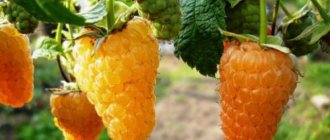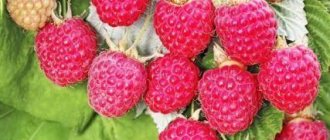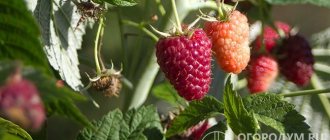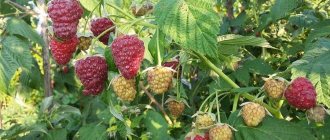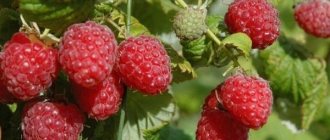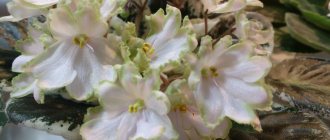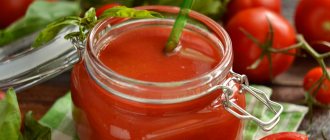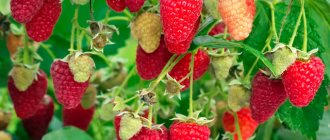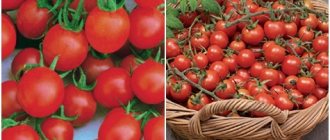Characteristics, description
In the authors' description, Atlant is presented as a remontant variety that forms a powerful compact bush. The height of the plant is 1.6–2 m, the shoots grow straight up, which allows the gardener to form the bush like a tree into one central trunk with skeletal shoots. The thorns inherent in the crop grow on the branches mainly at the bottom; they are soft and do not impede harvesting. As they mature, the branches change color from emerald to a darker green with a red tint. The foliage is medium-sized, veined, and mottled with wrinkles. The upper part of the leaf is green, the underside is pale. The shape of the leaf plate is an elongated triangle with a sharp tip.
The berries are shaped like an elongated cone with a blunt end and are bright crimson in color. The drupes are tightly pressed to each other and have a glossy sheen. According to reviews, the taste is rich, sweet, with a refreshing sour note. The fruits are fragrant and juicy, good both fresh and processed for the winter.
Did you know? Raspberry leaves and berries contain a large amount of salicylic acid, so it helps reduce fever. By the way, salicylic acid is the main component of aspirin.
Secrets of growing remontant raspberries
Remontability of a plant (from the French “remontant” - blooming again) is the ability to bear fruit again during one growing season. Remontant raspberries can produce crops on both annual and biennial shoots. The formation of two harvests per season creates the impression of continuous fruiting of superraspberries from July until the autumn frosts.
During the season, raspberries yield twice.
Techniques for growing remontant varieties have their own specific features.
In the spring, the overwintered underground part of the bush expels young shoots. In the summer of this year, flowers appear on them, and in mid-August the berries of the autumn harvest begin to ripen. By winter, the upper part of the shoots, which have finished bearing fruit, dies off. The rest overwinters, like ordinary raspberries, and in the second year forms fruit branches that produce a summer harvest. Two-year-old stems are cut out immediately after harvest.
Southern strip of Russia
Scientists have incorporated such a development program into remontant varieties. And horticultural practice has shown that according to the proposed scheme, two full-fledged harvests can be obtained only in the southern regions of Russia.
In the middle zone, the fruits of the first (summer) harvest are small and not juicy enough. By the second wave of fruiting, the plant simply does not have time to gain strength, and not all berries, as a rule, ripen before the onset of cold weather. The mother bush is forced to distribute its forces between the formation of the summer harvest and the development of daughter shoots.
For abundant fruiting, you can plant ordinary and remontant raspberries.
Therefore, for most regions, it is recommended to combine two waves of fruiting into one , abundant autumn, cultivating remontant raspberries in an annual crop. In this case, in late autumn, all shoots are cut out at soil level. The offspring that appear in the spring of the next year give an earlier (already in August) and abundant harvest. After the autumn leaves fall, the shoots are all cut off again.
You can enjoy the taste of wonderful berries throughout both summer and autumn by planting both ordinary and remontant raspberries on your plot.
Advantages and disadvantages
Atlant is popular among summer residents due to its good yield, excellent taste and universal use of berries. In addition, the large-fruited crop is resistant to pest attacks and disease. Another feature is inherent in ripe fruits: they do not crumble, but stay on the stalk for quite a long time.
Drought resistance, frost resistance
Despite the extensive root system, the crop is not able to survive a long drought without losing the taste of the berries. This disadvantage is compensated by the high frost resistance of the variety. Raspberries are covered only in case of gentle pre-winter pruning.
With a lack of moisture, the fruits become sour and even bitter.
Productivity and fruiting
Raspberries are highly productive: up to 3 kg of fruits are collected from the bush during one fruiting. Like all remontant varieties, Atlant bears fruit twice a season. The first harvest ripens in July. The second time the fruits are harvested at the end of August - beginning of September.
Accelerate harvesting
The speed at which the crop appears depends on the speed of development, growth and elongation of the stems. Some gardeners deliberately speed up this process by covering the raspberry tree in late February - early March with a specialized covering made of perforated film or non-woven material.
When the shoots reach a length of 15 cm, the covering is removed. This method will help you harvest the harvest as much as 2 weeks ahead of schedule. You can pick Atlant raspberries once every 7 days.
Atlant raspberries are amazing, they have received the deepest recognition and wonderful positive feedback from gardeners, summer residents and simply lovers of fresh berries. It is valued primarily for its strength of taste and strict appearance. The berry is distinguished from other varieties due to its high frost resistance and protection against various diseases. This look will please even the most severe critic.
Landing Features
Successful cultivation of the described plant depends on many factors. An important role is played by the correctly selected landing site and timing of the procedure.
Deadlines
Theoretically, raspberries can be planted in spring and summer, but in practice the timing depends on the growing region. In the south, where spring is early, autumn planting is preferable. Before frost, the seedling manages to take root and overwinters without loss. In the spring (in the south), the buds will bloom faster than the roots have time to take root, which will lead to the death of the bush.
conclusions
Every gardener is his own director. Taking into account local climatic conditions and his desire, he chooses both the method of cultivating raspberries and the type of pruning.
Pruning raspberries depends on climatic conditions.
Both classic and innovative raspberry varieties deserve the attention of their connoisseurs. A true raspberry lover will house both of them in his garden and will enjoy the berry conveyor belt and the progress of plant growing all season long.
Rules of care
If mulch is used, raspberries do not need frequent watering. The main thing is to ensure that the soil is always moistened to a depth of 30 cm. When watering, always use warm water that has been separated from impurities (cold water can cause plant disease). If there is regular precipitation in the summer, then watering is kept to a minimum. After the moistening procedure, the soil needs to be loosened and weeded.
Did you know? According to historical information, the first people to cultivate raspberries were the ancient Romans 5,000 thousand years ago.
Atlas needs to be fertilized about 3 times per season:
- in the spring, after the buds awaken , use mullein infusion, prepared in a ratio of 1:10, about 1.5 liters are needed per bush;
- during the flowering period - wood ash (200 g/10 l of water) or nettle infusion to saturate the plant with potassium;
- during the fruiting period - potassium sulfate (30 g), superphosphate (40 g) are mixed in 10 liters of water.
Maintenance procedures include pruning. It is needed to form a compact, not dense crown, through which the berries will be evenly illuminated. During pruning, broken or frozen branches are also removed. The tops of the shoots are trimmed to stimulate fruiting.
Reviews from gardeners
It is not surprising that gardeners’ reviews of Atlant raspberries are positive and even delightful, because it seems that this raspberry has practically no drawbacks.
What I like about remontant raspberry varieties is their resistance to all sorts of diseases and pests do not touch them, since they already have time to retire by the time the first ovaries appear. Atlas is really good for everyone: large, productive and even tasty, which is a comparative rarity among remontant varieties. Of course, it requires care, primarily watering and fertilizing, but what kind of raspberry can do without them. And it propagates quite easily - I usually use cuttings, which I receive in the fall after cutting off all the shoots. On average, 50% take root, but this is not bad - anyway, they are mostly thrown away. I have grown different raspberries throughout my life, but I just can’t get used to the remontant ones. It’s wonderful to somehow cut it off completely before winter. But for the second year now I have been trying the Atlant variety on my plot, and it makes me very happy. In the spring, such strong, beautiful shoots emerge, and when it blooms, it’s just a sight for sore eyes. There is no need to treat it with anything, it grows on its own and does not hurt anything. Well, the most interesting thing is that in the fall, even the raspberry spirit has disappeared from people’s plots, but my raspberries ripen in the garden and are so tasty and aromatic that it’s just a miracle. We are engaged in growing raspberries for sale and Atlant, although a relatively new variety, has already become one of the top five favorites. The berry is wonderful - tasty, juicy, very attractive in appearance and at the same time easily transportable.
Preparing for winter
In autumn, the bush is pruned, leaving only short shoots. This approach will allow the plant to overwinter without loss, and in addition, it will not give the pest larvae a chance to hide in the bark. When grown in the southern regions, pruning before winter is more gentle.
The variety is winter-hardy, but in particularly cold or snowless winters it will need shelter. You can use any agricultural material and spruce branches, straw or sawdust mulch.
Reproduction methods
Atlas is propagated in several vegetative ways:
- Green cuttings - apical shoots up to 15 cm in size are cut from a healthy bush at an angle of 45°. Trim the top, remove all leaves, leaving a couple. Then, in a humid environment, in a warm environment at +25...+30°C, the roots are left to grow in the soil. Before placing it in the ground, grooves are scratched at the end of the cutting with a knife and kept in Heteroauxin for about an hour.
- Lignified root shoots are rooted in the same way , cutting them from last year's shoots. The length of the cutting is about 5 cm, it should have a leafy rosette and white roots.
- Reproduction by layering . The root shoots are placed in a previously prepared furrow, secured with staples and sprinkled with soil, leaving a small top above the surface.
- When transplanting a bush to a new location, it can be carefully divided into parts with foliage and its own root system .

